Report on Enhancing Communication Management in Organizations
VerifiedAdded on 2023/03/21
|9
|1799
|40
Report
AI Summary
This report provides a comprehensive analysis of communication management within business organizations, emphasizing the importance of stakeholder communication, identifying key barriers to effective communication such as cultural diversity and language differences, and exploring methods for overcoming these challenges. It delves into the influence of factors like position differences, culture, and values on communication styles, and examines how technological advancements impact business communications. The report also includes a personal evaluation of interpersonal communication skills, feedback mechanisms, and a personal development plan focusing on communication improvement. Furthermore, it outlines steps for conducting a communication audit in the workplace, discusses relevant organizational communication theories, and proposes a workplace communication plan with measurable outcomes, highlighting the significance of clear roles, responsibilities, and strategic communication tactics. Desklib provides this and other resources for students.
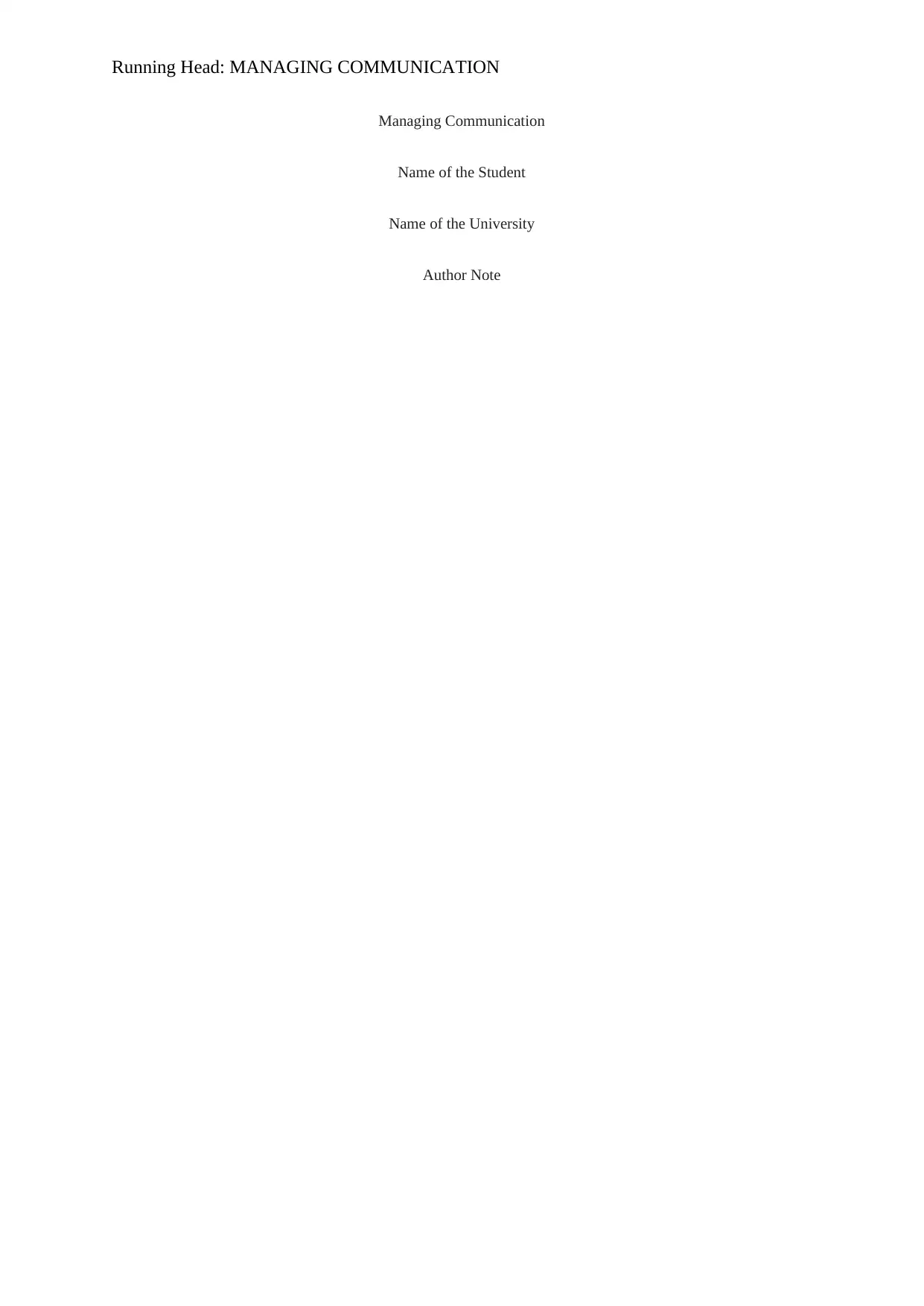
Running Head: MANAGING COMMUNICATION
Managing Communication
Name of the Student
Name of the University
Author Note
Managing Communication
Name of the Student
Name of the University
Author Note
Paraphrase This Document
Need a fresh take? Get an instant paraphrase of this document with our AI Paraphraser
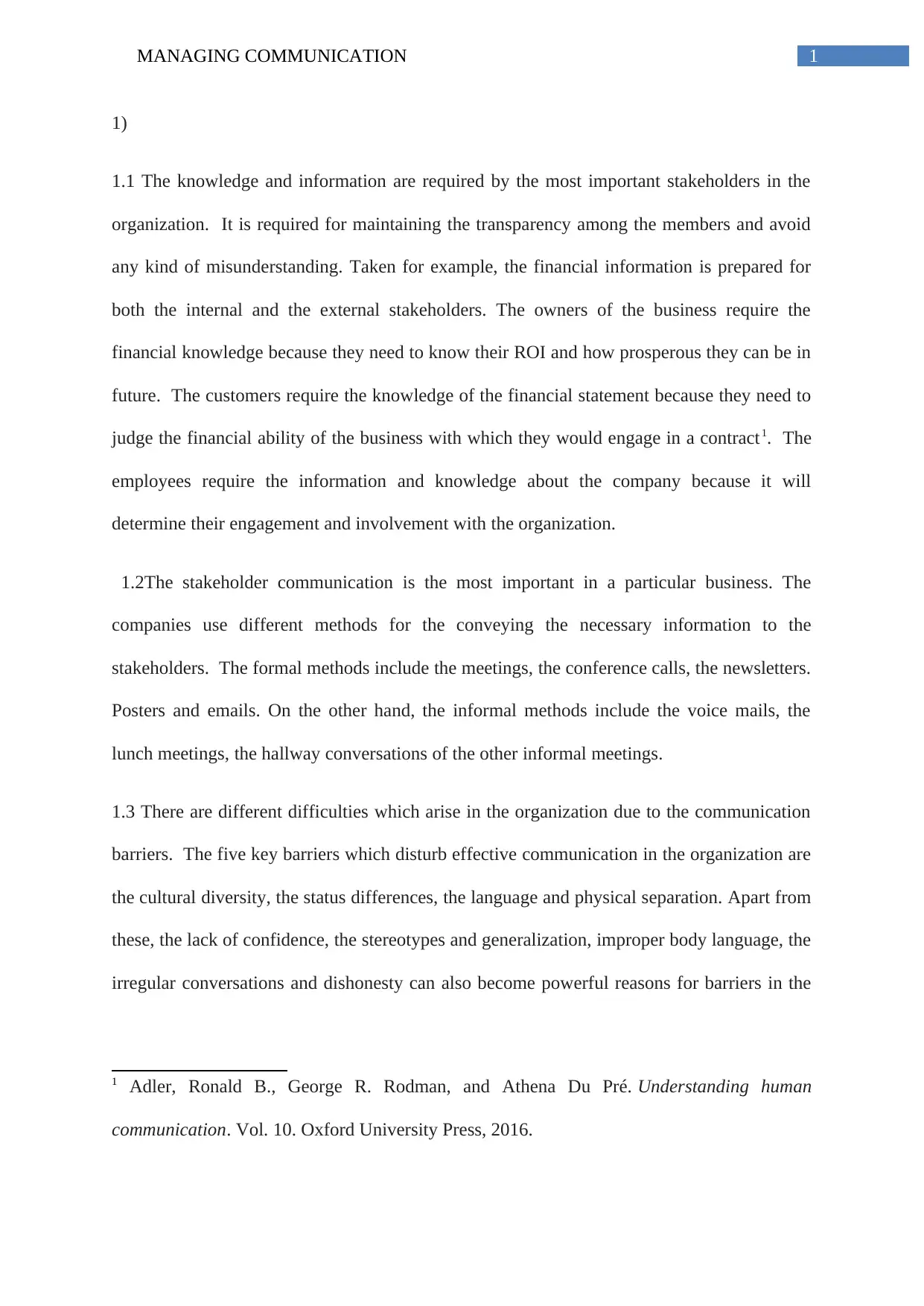
1MANAGING COMMUNICATION
1)
1.1 The knowledge and information are required by the most important stakeholders in the
organization. It is required for maintaining the transparency among the members and avoid
any kind of misunderstanding. Taken for example, the financial information is prepared for
both the internal and the external stakeholders. The owners of the business require the
financial knowledge because they need to know their ROI and how prosperous they can be in
future. The customers require the knowledge of the financial statement because they need to
judge the financial ability of the business with which they would engage in a contract1. The
employees require the information and knowledge about the company because it will
determine their engagement and involvement with the organization.
1.2The stakeholder communication is the most important in a particular business. The
companies use different methods for the conveying the necessary information to the
stakeholders. The formal methods include the meetings, the conference calls, the newsletters.
Posters and emails. On the other hand, the informal methods include the voice mails, the
lunch meetings, the hallway conversations of the other informal meetings.
1.3 There are different difficulties which arise in the organization due to the communication
barriers. The five key barriers which disturb effective communication in the organization are
the cultural diversity, the status differences, the language and physical separation. Apart from
these, the lack of confidence, the stereotypes and generalization, improper body language, the
irregular conversations and dishonesty can also become powerful reasons for barriers in the
1 Adler, Ronald B., George R. Rodman, and Athena Du Pré. Understanding human
communication. Vol. 10. Oxford University Press, 2016.
1)
1.1 The knowledge and information are required by the most important stakeholders in the
organization. It is required for maintaining the transparency among the members and avoid
any kind of misunderstanding. Taken for example, the financial information is prepared for
both the internal and the external stakeholders. The owners of the business require the
financial knowledge because they need to know their ROI and how prosperous they can be in
future. The customers require the knowledge of the financial statement because they need to
judge the financial ability of the business with which they would engage in a contract1. The
employees require the information and knowledge about the company because it will
determine their engagement and involvement with the organization.
1.2The stakeholder communication is the most important in a particular business. The
companies use different methods for the conveying the necessary information to the
stakeholders. The formal methods include the meetings, the conference calls, the newsletters.
Posters and emails. On the other hand, the informal methods include the voice mails, the
lunch meetings, the hallway conversations of the other informal meetings.
1.3 There are different difficulties which arise in the organization due to the communication
barriers. The five key barriers which disturb effective communication in the organization are
the cultural diversity, the status differences, the language and physical separation. Apart from
these, the lack of confidence, the stereotypes and generalization, improper body language, the
irregular conversations and dishonesty can also become powerful reasons for barriers in the
1 Adler, Ronald B., George R. Rodman, and Athena Du Pré. Understanding human
communication. Vol. 10. Oxford University Press, 2016.
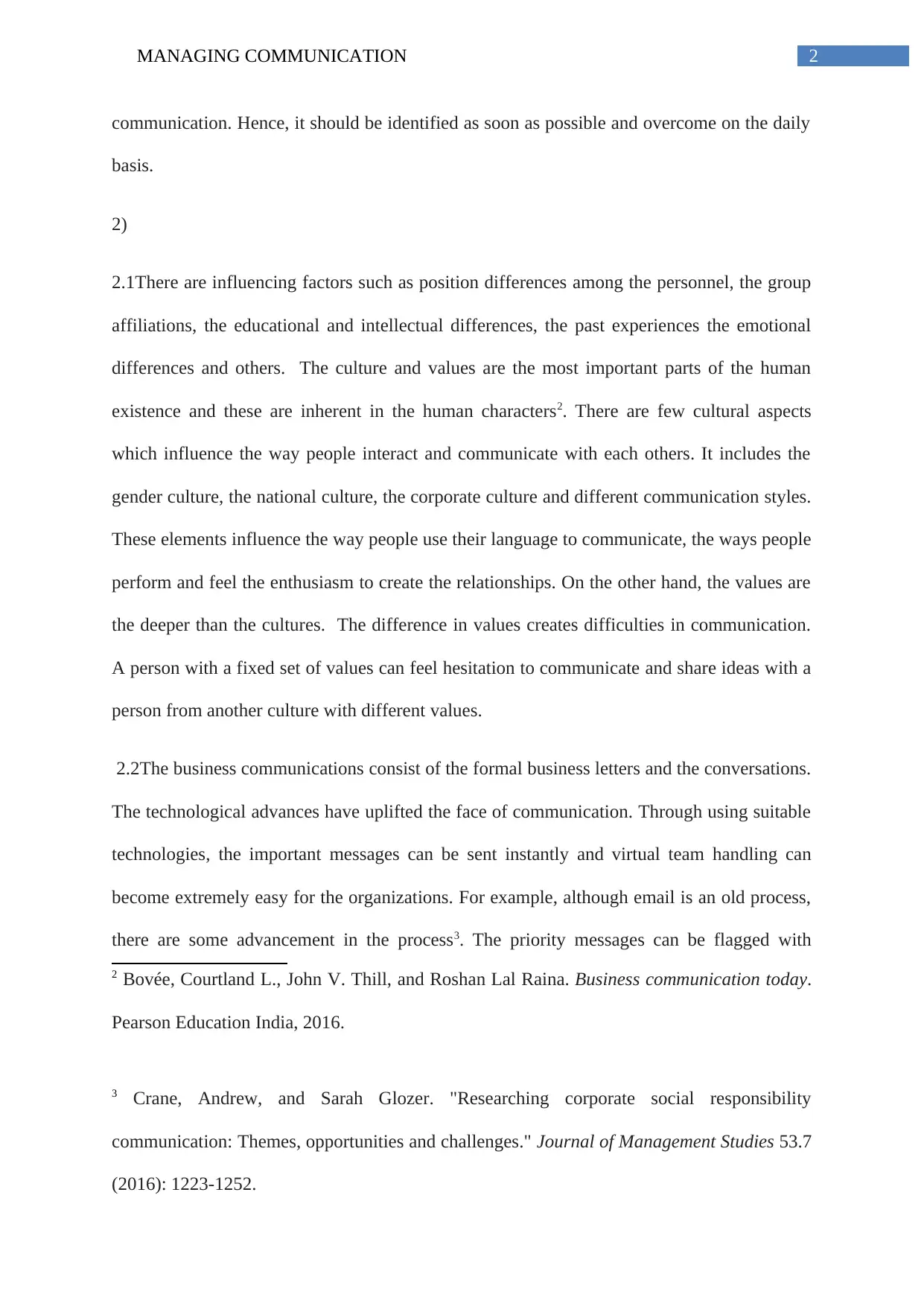
2MANAGING COMMUNICATION
communication. Hence, it should be identified as soon as possible and overcome on the daily
basis.
2)
2.1There are influencing factors such as position differences among the personnel, the group
affiliations, the educational and intellectual differences, the past experiences the emotional
differences and others. The culture and values are the most important parts of the human
existence and these are inherent in the human characters2. There are few cultural aspects
which influence the way people interact and communicate with each others. It includes the
gender culture, the national culture, the corporate culture and different communication styles.
These elements influence the way people use their language to communicate, the ways people
perform and feel the enthusiasm to create the relationships. On the other hand, the values are
the deeper than the cultures. The difference in values creates difficulties in communication.
A person with a fixed set of values can feel hesitation to communicate and share ideas with a
person from another culture with different values.
2.2The business communications consist of the formal business letters and the conversations.
The technological advances have uplifted the face of communication. Through using suitable
technologies, the important messages can be sent instantly and virtual team handling can
become extremely easy for the organizations. For example, although email is an old process,
there are some advancement in the process3. The priority messages can be flagged with
2 Bovée, Courtland L., John V. Thill, and Roshan Lal Raina. Business communication today.
Pearson Education India, 2016.
3 Crane, Andrew, and Sarah Glozer. "Researching corporate social responsibility
communication: Themes, opportunities and challenges." Journal of Management Studies 53.7
(2016): 1223-1252.
communication. Hence, it should be identified as soon as possible and overcome on the daily
basis.
2)
2.1There are influencing factors such as position differences among the personnel, the group
affiliations, the educational and intellectual differences, the past experiences the emotional
differences and others. The culture and values are the most important parts of the human
existence and these are inherent in the human characters2. There are few cultural aspects
which influence the way people interact and communicate with each others. It includes the
gender culture, the national culture, the corporate culture and different communication styles.
These elements influence the way people use their language to communicate, the ways people
perform and feel the enthusiasm to create the relationships. On the other hand, the values are
the deeper than the cultures. The difference in values creates difficulties in communication.
A person with a fixed set of values can feel hesitation to communicate and share ideas with a
person from another culture with different values.
2.2The business communications consist of the formal business letters and the conversations.
The technological advances have uplifted the face of communication. Through using suitable
technologies, the important messages can be sent instantly and virtual team handling can
become extremely easy for the organizations. For example, although email is an old process,
there are some advancement in the process3. The priority messages can be flagged with
2 Bovée, Courtland L., John V. Thill, and Roshan Lal Raina. Business communication today.
Pearson Education India, 2016.
3 Crane, Andrew, and Sarah Glozer. "Researching corporate social responsibility
communication: Themes, opportunities and challenges." Journal of Management Studies 53.7
(2016): 1223-1252.
⊘ This is a preview!⊘
Do you want full access?
Subscribe today to unlock all pages.

Trusted by 1+ million students worldwide

3MANAGING COMMUNICATION
follow –up. The program alerts can be set when the messages arrive from the VIP senders.
The automated voice response systems are also useful in the communication. However, there
are some downsides too such as decreased productivity due to ‘always connectedness
‘.Employees do not even take break and in an always working condition.
2.3The policies and the procedures in the organization can have greater impact on the
communication among the different levels of staffs. The policies and the procedures
sometimes keep the communication process more restricted. A communication gap occurs
when one employee of the business feel dominated by the policies and cannot communicate
that to the upper level of the management.
3)
3.1 In order to evaluate my own personal communication skills, I have undergone the
personal communication skills test. There were 20 questions related to the elements of the
interpersonal skills. The interpersonal communication is the process through which the
interpersonal skills, the information exchange, the verbal and non-verbal messages and face
to face communication occur4. I have scored between 6.8- 7.9 out of 10. As per the ratings , I
have good interpersonal communication skills but there are areas too where I need
improvement.
3.2There are different theories related to the interpersonal communication such as the
uncertainty reduction theory, the social exchange theory, the symbolic interaction theory, the
relational dialectics theory, the social penetration theory and many others. As per this theory,
4 Hargie, Owen. Skilled interpersonal communication: Research, theory and practice.
Routledge, 2016.
follow –up. The program alerts can be set when the messages arrive from the VIP senders.
The automated voice response systems are also useful in the communication. However, there
are some downsides too such as decreased productivity due to ‘always connectedness
‘.Employees do not even take break and in an always working condition.
2.3The policies and the procedures in the organization can have greater impact on the
communication among the different levels of staffs. The policies and the procedures
sometimes keep the communication process more restricted. A communication gap occurs
when one employee of the business feel dominated by the policies and cannot communicate
that to the upper level of the management.
3)
3.1 In order to evaluate my own personal communication skills, I have undergone the
personal communication skills test. There were 20 questions related to the elements of the
interpersonal skills. The interpersonal communication is the process through which the
interpersonal skills, the information exchange, the verbal and non-verbal messages and face
to face communication occur4. I have scored between 6.8- 7.9 out of 10. As per the ratings , I
have good interpersonal communication skills but there are areas too where I need
improvement.
3.2There are different theories related to the interpersonal communication such as the
uncertainty reduction theory, the social exchange theory, the symbolic interaction theory, the
relational dialectics theory, the social penetration theory and many others. As per this theory,
4 Hargie, Owen. Skilled interpersonal communication: Research, theory and practice.
Routledge, 2016.
Paraphrase This Document
Need a fresh take? Get an instant paraphrase of this document with our AI Paraphraser
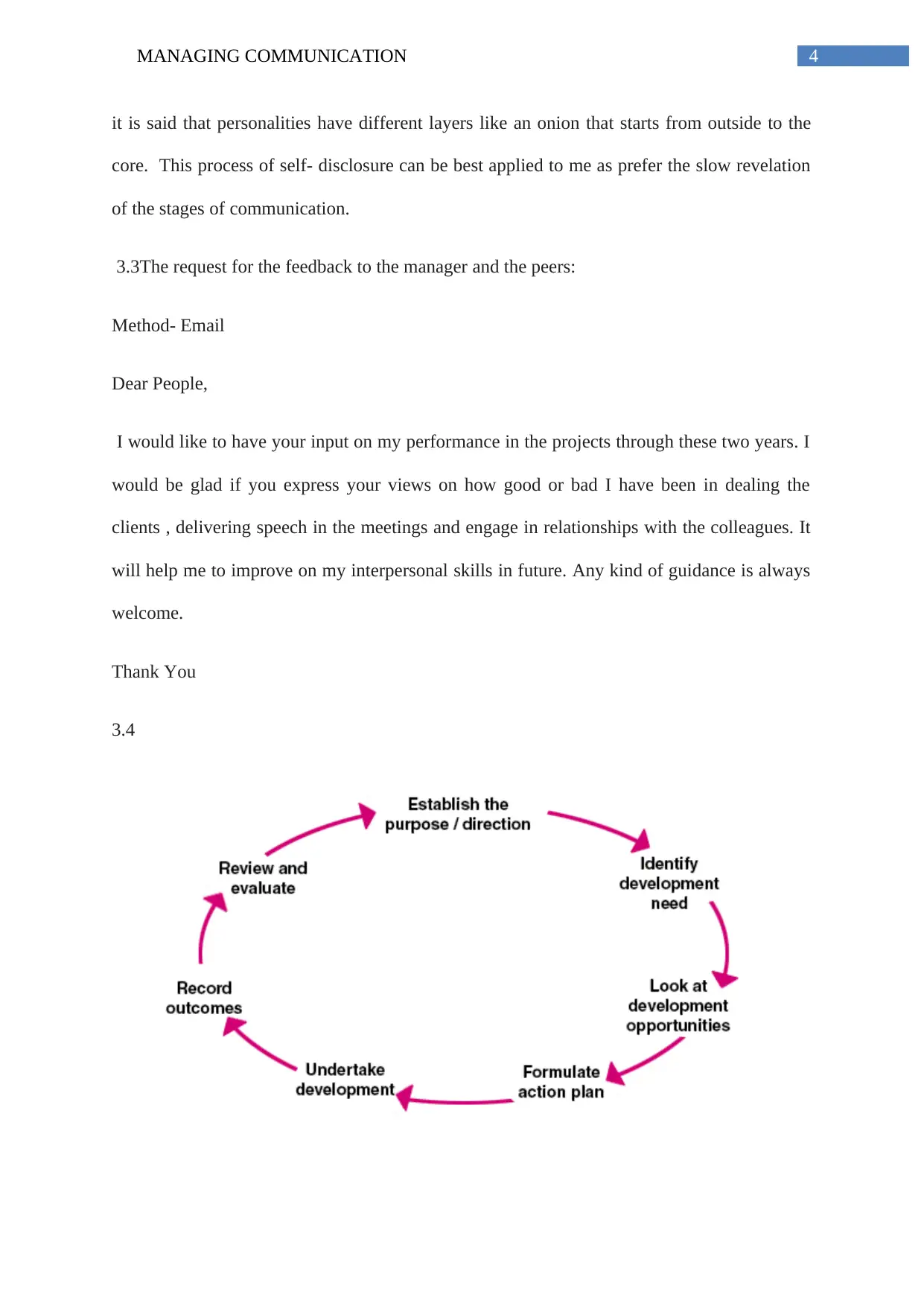
4MANAGING COMMUNICATION
it is said that personalities have different layers like an onion that starts from outside to the
core. This process of self- disclosure can be best applied to me as prefer the slow revelation
of the stages of communication.
3.3The request for the feedback to the manager and the peers:
Method- Email
Dear People,
I would like to have your input on my performance in the projects through these two years. I
would be glad if you express your views on how good or bad I have been in dealing the
clients , delivering speech in the meetings and engage in relationships with the colleagues. It
will help me to improve on my interpersonal skills in future. Any kind of guidance is always
welcome.
Thank You
3.4
it is said that personalities have different layers like an onion that starts from outside to the
core. This process of self- disclosure can be best applied to me as prefer the slow revelation
of the stages of communication.
3.3The request for the feedback to the manager and the peers:
Method- Email
Dear People,
I would like to have your input on my performance in the projects through these two years. I
would be glad if you express your views on how good or bad I have been in dealing the
clients , delivering speech in the meetings and engage in relationships with the colleagues. It
will help me to improve on my interpersonal skills in future. Any kind of guidance is always
welcome.
Thank You
3.4
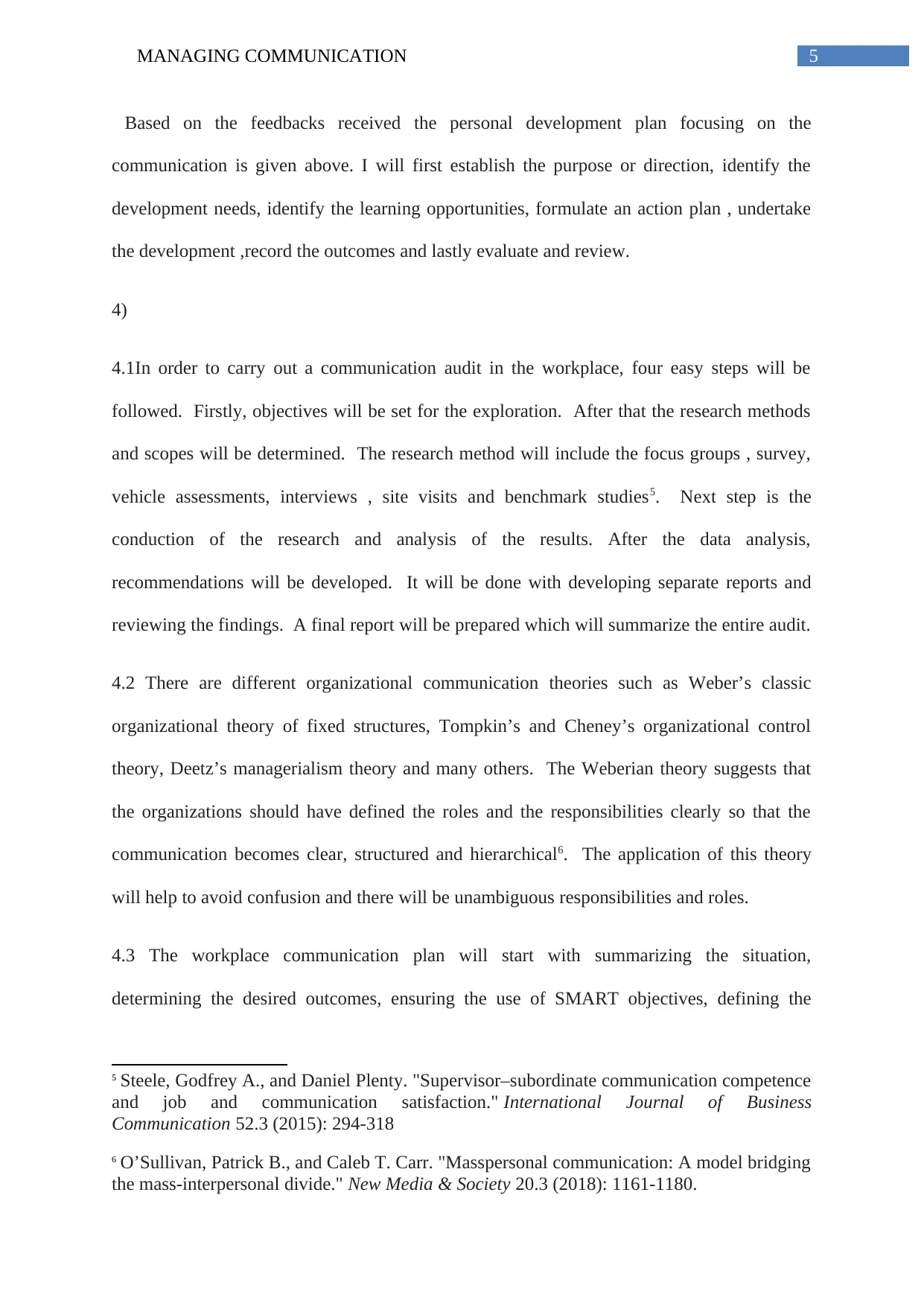
5MANAGING COMMUNICATION
Based on the feedbacks received the personal development plan focusing on the
communication is given above. I will first establish the purpose or direction, identify the
development needs, identify the learning opportunities, formulate an action plan , undertake
the development ,record the outcomes and lastly evaluate and review.
4)
4.1In order to carry out a communication audit in the workplace, four easy steps will be
followed. Firstly, objectives will be set for the exploration. After that the research methods
and scopes will be determined. The research method will include the focus groups , survey,
vehicle assessments, interviews , site visits and benchmark studies5. Next step is the
conduction of the research and analysis of the results. After the data analysis,
recommendations will be developed. It will be done with developing separate reports and
reviewing the findings. A final report will be prepared which will summarize the entire audit.
4.2 There are different organizational communication theories such as Weber’s classic
organizational theory of fixed structures, Tompkin’s and Cheney’s organizational control
theory, Deetz’s managerialism theory and many others. The Weberian theory suggests that
the organizations should have defined the roles and the responsibilities clearly so that the
communication becomes clear, structured and hierarchical6. The application of this theory
will help to avoid confusion and there will be unambiguous responsibilities and roles.
4.3 The workplace communication plan will start with summarizing the situation,
determining the desired outcomes, ensuring the use of SMART objectives, defining the
5 Steele, Godfrey A., and Daniel Plenty. "Supervisor–subordinate communication competence
and job and communication satisfaction." International Journal of Business
Communication 52.3 (2015): 294-318
6 O’Sullivan, Patrick B., and Caleb T. Carr. "Masspersonal communication: A model bridging
the mass-interpersonal divide." New Media & Society 20.3 (2018): 1161-1180.
Based on the feedbacks received the personal development plan focusing on the
communication is given above. I will first establish the purpose or direction, identify the
development needs, identify the learning opportunities, formulate an action plan , undertake
the development ,record the outcomes and lastly evaluate and review.
4)
4.1In order to carry out a communication audit in the workplace, four easy steps will be
followed. Firstly, objectives will be set for the exploration. After that the research methods
and scopes will be determined. The research method will include the focus groups , survey,
vehicle assessments, interviews , site visits and benchmark studies5. Next step is the
conduction of the research and analysis of the results. After the data analysis,
recommendations will be developed. It will be done with developing separate reports and
reviewing the findings. A final report will be prepared which will summarize the entire audit.
4.2 There are different organizational communication theories such as Weber’s classic
organizational theory of fixed structures, Tompkin’s and Cheney’s organizational control
theory, Deetz’s managerialism theory and many others. The Weberian theory suggests that
the organizations should have defined the roles and the responsibilities clearly so that the
communication becomes clear, structured and hierarchical6. The application of this theory
will help to avoid confusion and there will be unambiguous responsibilities and roles.
4.3 The workplace communication plan will start with summarizing the situation,
determining the desired outcomes, ensuring the use of SMART objectives, defining the
5 Steele, Godfrey A., and Daniel Plenty. "Supervisor–subordinate communication competence
and job and communication satisfaction." International Journal of Business
Communication 52.3 (2015): 294-318
6 O’Sullivan, Patrick B., and Caleb T. Carr. "Masspersonal communication: A model bridging
the mass-interpersonal divide." New Media & Society 20.3 (2018): 1161-1180.
⊘ This is a preview!⊘
Do you want full access?
Subscribe today to unlock all pages.

Trusted by 1+ million students worldwide
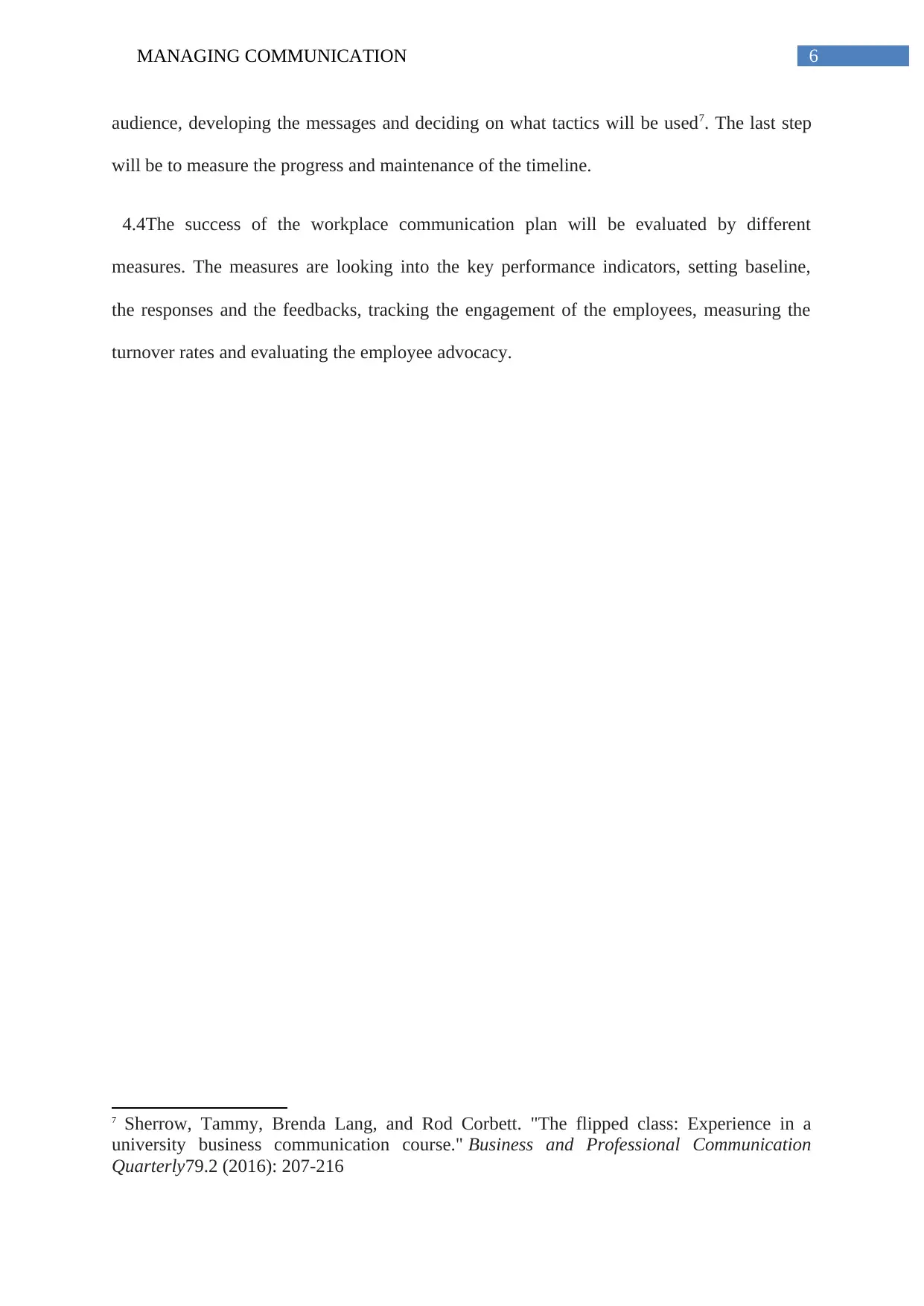
6MANAGING COMMUNICATION
audience, developing the messages and deciding on what tactics will be used7. The last step
will be to measure the progress and maintenance of the timeline.
4.4The success of the workplace communication plan will be evaluated by different
measures. The measures are looking into the key performance indicators, setting baseline,
the responses and the feedbacks, tracking the engagement of the employees, measuring the
turnover rates and evaluating the employee advocacy.
7 Sherrow, Tammy, Brenda Lang, and Rod Corbett. "The flipped class: Experience in a
university business communication course." Business and Professional Communication
Quarterly79.2 (2016): 207-216
audience, developing the messages and deciding on what tactics will be used7. The last step
will be to measure the progress and maintenance of the timeline.
4.4The success of the workplace communication plan will be evaluated by different
measures. The measures are looking into the key performance indicators, setting baseline,
the responses and the feedbacks, tracking the engagement of the employees, measuring the
turnover rates and evaluating the employee advocacy.
7 Sherrow, Tammy, Brenda Lang, and Rod Corbett. "The flipped class: Experience in a
university business communication course." Business and Professional Communication
Quarterly79.2 (2016): 207-216
Paraphrase This Document
Need a fresh take? Get an instant paraphrase of this document with our AI Paraphraser
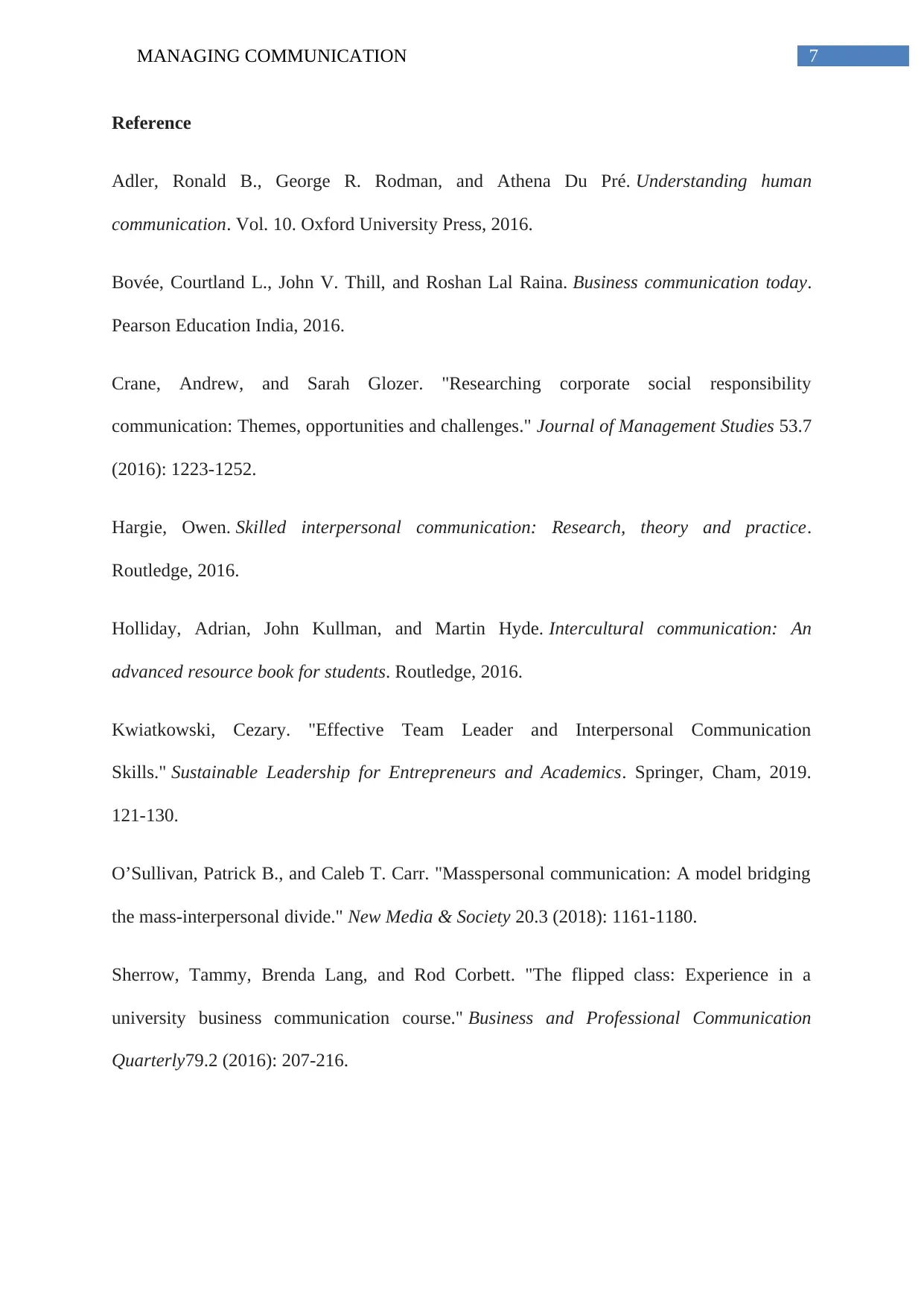
7MANAGING COMMUNICATION
Reference
Adler, Ronald B., George R. Rodman, and Athena Du Pré. Understanding human
communication. Vol. 10. Oxford University Press, 2016.
Bovée, Courtland L., John V. Thill, and Roshan Lal Raina. Business communication today.
Pearson Education India, 2016.
Crane, Andrew, and Sarah Glozer. "Researching corporate social responsibility
communication: Themes, opportunities and challenges." Journal of Management Studies 53.7
(2016): 1223-1252.
Hargie, Owen. Skilled interpersonal communication: Research, theory and practice.
Routledge, 2016.
Holliday, Adrian, John Kullman, and Martin Hyde. Intercultural communication: An
advanced resource book for students. Routledge, 2016.
Kwiatkowski, Cezary. "Effective Team Leader and Interpersonal Communication
Skills." Sustainable Leadership for Entrepreneurs and Academics. Springer, Cham, 2019.
121-130.
O’Sullivan, Patrick B., and Caleb T. Carr. "Masspersonal communication: A model bridging
the mass-interpersonal divide." New Media & Society 20.3 (2018): 1161-1180.
Sherrow, Tammy, Brenda Lang, and Rod Corbett. "The flipped class: Experience in a
university business communication course." Business and Professional Communication
Quarterly79.2 (2016): 207-216.
Reference
Adler, Ronald B., George R. Rodman, and Athena Du Pré. Understanding human
communication. Vol. 10. Oxford University Press, 2016.
Bovée, Courtland L., John V. Thill, and Roshan Lal Raina. Business communication today.
Pearson Education India, 2016.
Crane, Andrew, and Sarah Glozer. "Researching corporate social responsibility
communication: Themes, opportunities and challenges." Journal of Management Studies 53.7
(2016): 1223-1252.
Hargie, Owen. Skilled interpersonal communication: Research, theory and practice.
Routledge, 2016.
Holliday, Adrian, John Kullman, and Martin Hyde. Intercultural communication: An
advanced resource book for students. Routledge, 2016.
Kwiatkowski, Cezary. "Effective Team Leader and Interpersonal Communication
Skills." Sustainable Leadership for Entrepreneurs and Academics. Springer, Cham, 2019.
121-130.
O’Sullivan, Patrick B., and Caleb T. Carr. "Masspersonal communication: A model bridging
the mass-interpersonal divide." New Media & Society 20.3 (2018): 1161-1180.
Sherrow, Tammy, Brenda Lang, and Rod Corbett. "The flipped class: Experience in a
university business communication course." Business and Professional Communication
Quarterly79.2 (2016): 207-216.
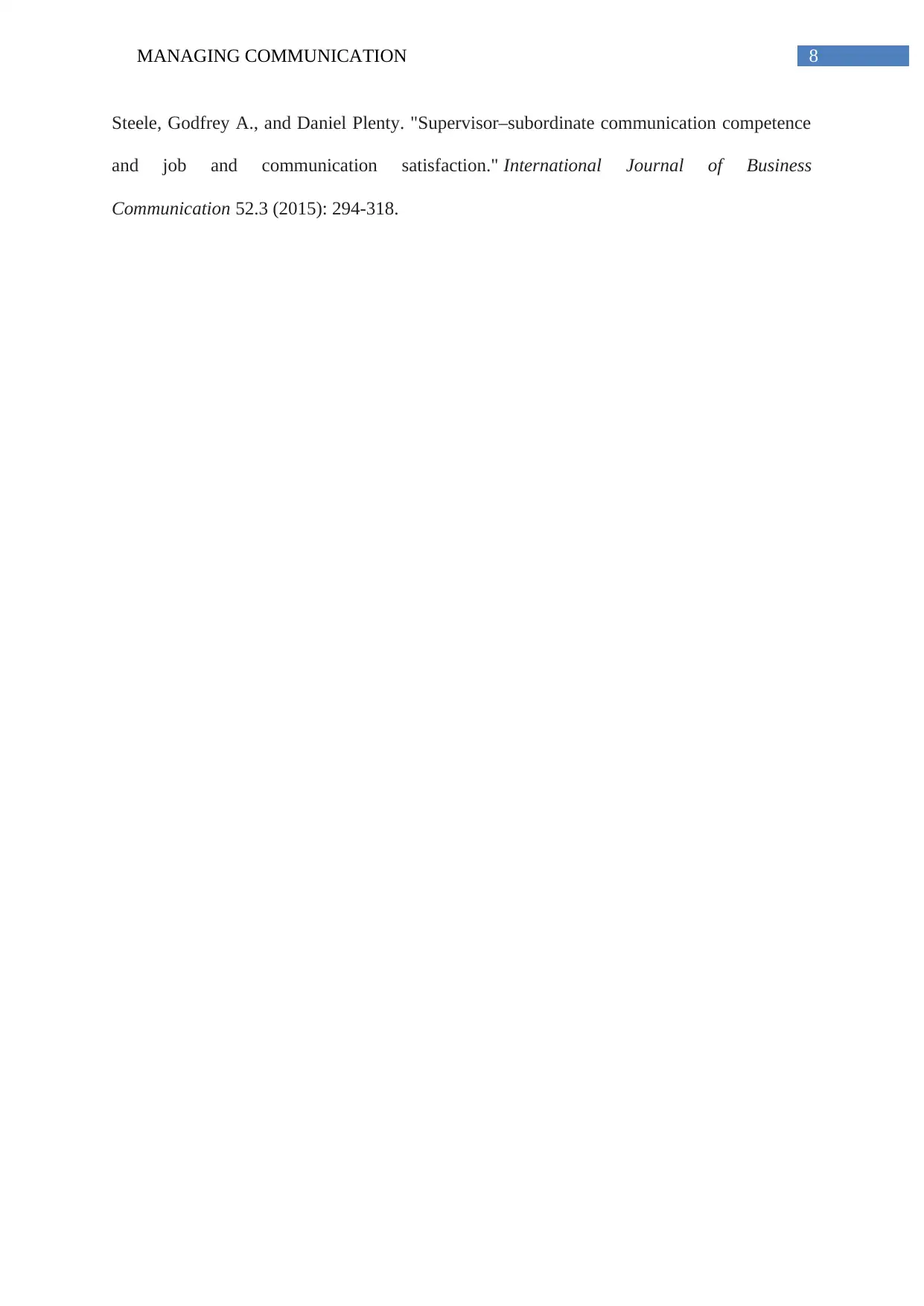
8MANAGING COMMUNICATION
Steele, Godfrey A., and Daniel Plenty. "Supervisor–subordinate communication competence
and job and communication satisfaction." International Journal of Business
Communication 52.3 (2015): 294-318.
Steele, Godfrey A., and Daniel Plenty. "Supervisor–subordinate communication competence
and job and communication satisfaction." International Journal of Business
Communication 52.3 (2015): 294-318.
⊘ This is a preview!⊘
Do you want full access?
Subscribe today to unlock all pages.

Trusted by 1+ million students worldwide
1 out of 9
Related Documents
Your All-in-One AI-Powered Toolkit for Academic Success.
+13062052269
info@desklib.com
Available 24*7 on WhatsApp / Email
![[object Object]](/_next/static/media/star-bottom.7253800d.svg)
Unlock your academic potential
Copyright © 2020–2025 A2Z Services. All Rights Reserved. Developed and managed by ZUCOL.





